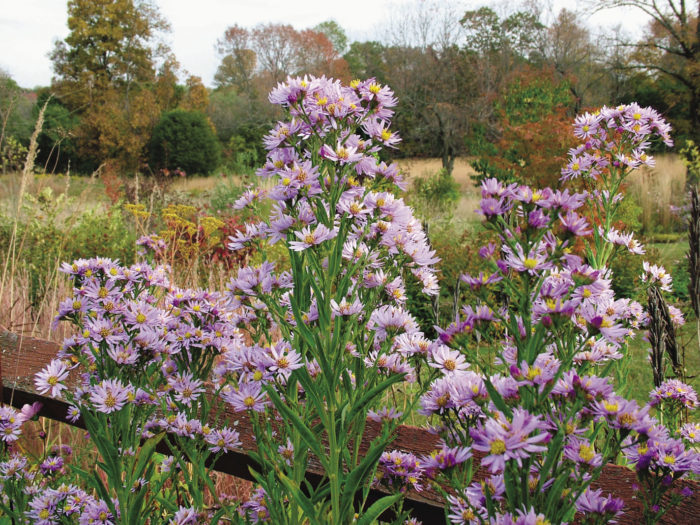
What would autumn be like without asters? Boring, that’s what. Thankfully, I live in a place with a plethora of native asters that dot and decorate roadsides, fields, woodlands, and wild spaces. Their ubiquitous nature sometimes saddles them with the reputation of looking too wild, and while you might get your fix of asters from these borrowed landscapes, I wouldn’t want to be without their cheery flowers in my garden, as well. Asters mark the changing seasons in a pageant of colors, blending beautifully with an assortment of grasses and other late-showing perennials.
Aster (the Greek word for “star”) is so-named for the starburst effect of its daisylike flowers, but I like to think that its stellar floral show has something to do with it, too. The botanical name of this autumnal star has changed from the simplicity of Aster to tongue twisters such as Doellengeria, Eurybia, and Symphyotrichum—confounding gardeners and professionals alike. Complicating matters a bit, the new names have not been universally embraced; the Royal Horticultural Society, for one, has not yet adopted the changes, but many botanical gardens, native-plant societies, and nurseries have already made the switch. Possibly more important than knowing the Latin name of a given plant is knowing if it is, in fact, a “star” or one of the many asters that, instead, become a disease-infested mess by midseason.
At a Glance: ‘Jindai’ Tatarian aster (photo above)
USDA Hardiness Zones: 4 to 8
Conditions: Full sun to partial shade; moderately fertile, moist, well-drained soil
Season: Flowers appear from late summer through fall.
Propagation: Divide in spring, every two to three years.
Pests: Verticillium wilt, gray mold, powdery mildew, rusts, white smut, aster yellows, and many fungal leaf spots and stem cankers. Also prone to rosy blister gall, aphids, mites, slugs, snails, and nematodes.
Without flowers, ‘Jindai’ Tatarian aster (Aster tataricus ‘Jindai’) might be difficult to peg as an aster. Coarse basal leaves, nearly 2 feet long, look like those of horseradish or tobacco. Flowering stems begin to grow in midsummer, eventually reaching up to 4 feet tall—that’s a good 2 to 3 feet shorter than the species. Come autumn, its lineage is no longer in doubt: Clusters of pretty violet-blue-and-yellow flowers bloom well into late fall and sometimes even early winter. The species has a reputation for spreading widely, and even though ‘Jindai’ makes a sizable patch in a few years, I have not found it to be a thug. Bold-textured ‘Jindai’ pairs well with small-leaved asters or any ornamental grass, be it short or tall.
Top performers that are worth a second look
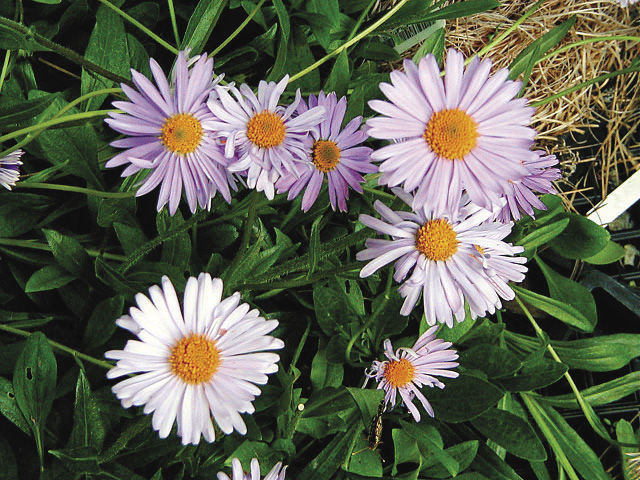
One of the heartbreaks of our trial was the lack of success in overwintering any cultivars of Frikart’s daisy (Aster × frikartii); they all balked at our wet winter soils. Luckily, we found that ‘Wartburgstern’ East Indies aster (Aster tongolensis ‘Wartburgstern’) is a hardy substitute. Vibrant, violet-blue flowers with bright orange centers hover 20 inches above the low mat of dark green leaves, which remain attractive all summer. Although ‘Wartburgstern’ (or ‘Wartburg Star’, as it is often called) is described as blooming all summer, we saw flowers for only about a month from early to midsummer. Sure, the shorter bloom period was disappointing, but that only made the flowers all the more precious.

The low mounding habit of ‘Snow Flurry’ white heath aster (Symphyotrichum ericoides ‘Snow Flurry’) sets it apart from other asters. Its arching stems seem to undulate across the ground, reaching nearly 4 feet wide but only 8 inches tall. ‘Snow Flurry’ makes a superb ground cover or edging plant, but it is utter perfection cascading over the edge of a wall or a container. No description of the diminutive flowers can do justice to the actual show: A veritable snowstorm of white flowers blanket the stems in autumn. The tiny linear leaves are more reminiscent of heaths (Erica spp. and cvs., Zones 5–11) than of asters. ‘Snow Flurry’ is also tolerant of dry conditions.
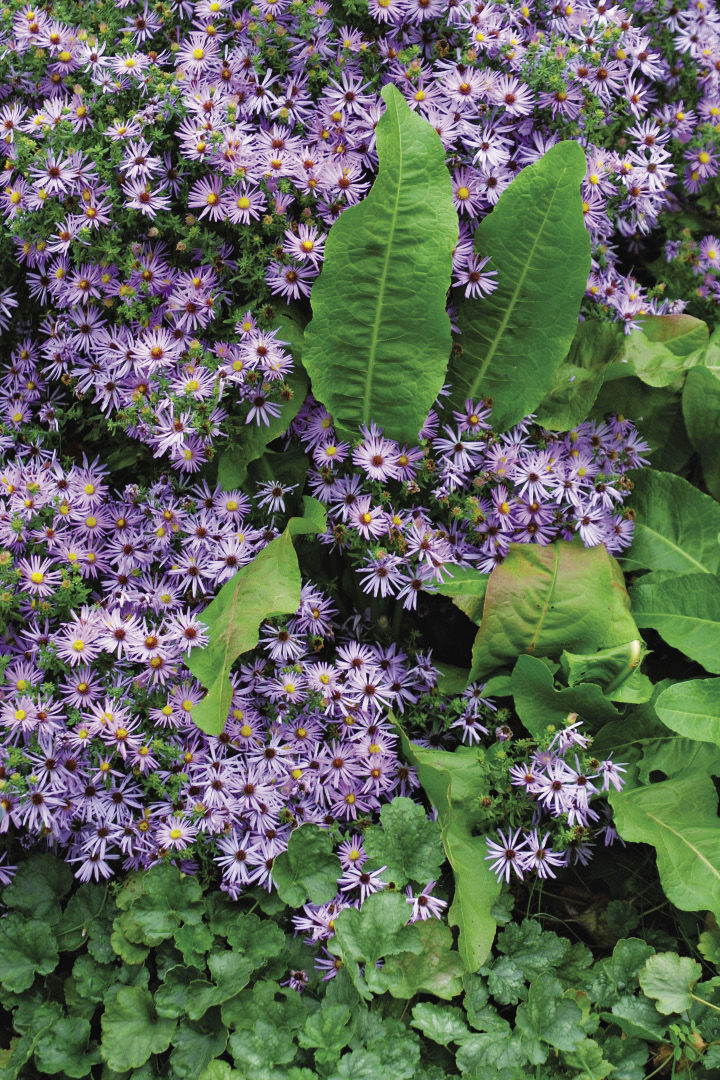
‘Raydon’s Favorite’ aromatic aster (Symphyotrichum oblongifolium ‘Raydon’s Favorite’) was fairly uncommon when we planted it but quickly became a perennial favorite in our trial. The plant is loaded with blue-purple flowers that keep appearing for a long time; in fact, the plant is so eager to get going that precocious blossoms pop up for several weeks before blooming begins in earnest in midsummer. A billowy habit gives ‘Raydon’s Favorite’ an informal look that suits it to mass plantings and naturalizing. Aromatic asters are better alternatives to New England asters (Symphyotrichum novae-angliae) because they are more resistant to powdery mildew. I think aromatic aster will play an important role in future plant breeding for disease-resistant cultivars and hybrids.

‘Eastern Star’ white wood aster (Eurybia divaricata ‘Eastern Star’) is one of the few asters that grows well in shady gardens, although some morning sun enhances its floral display. From midsummer on, smallish white flowers with yellow centers are borne aplenty on wiry, dark burgundy stems over dark green leaves. You can expect an upright mounded habit, similar to the species, but the cultivar ‘Eastern Star’ features larger flowers and darker green leaves. Its arching stems were a bit more recumbent, too, especially when weighed down with flowers. White wood aster is particularly fetching in large drifts in high-shade landscapes.
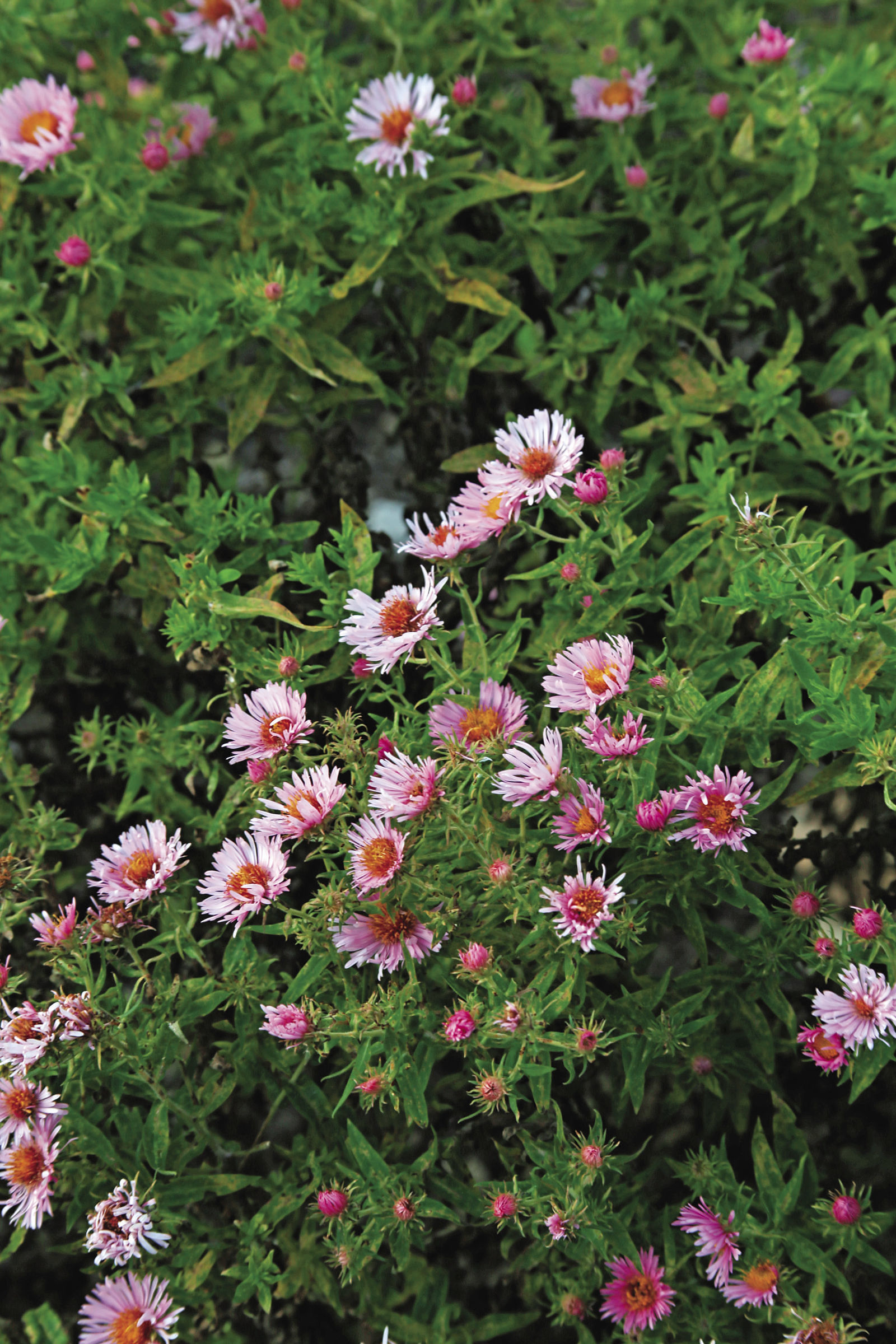
It was a friend who told me that ‘Kylie’ aster (Symphyotrichum ‘Kylie’), a hybrid of New England aster and heath aster, was a must-have for my trial. ‘Kylie’ seems to have gotten the best of both parents, with narrow, dark green leaves—free of rust and mildew—and a robust clumping habit. To be honest, the healthy foliage was quickly forgotten by autumn, when ‘Kylie’ turned into a soft pink cloud with scores of small semidouble flowers crowding the tops of the erect stems. Every year, ‘Kylie’ got both the butterfly vote and mine, proving that sometimes it pays to take a friend’s advice.
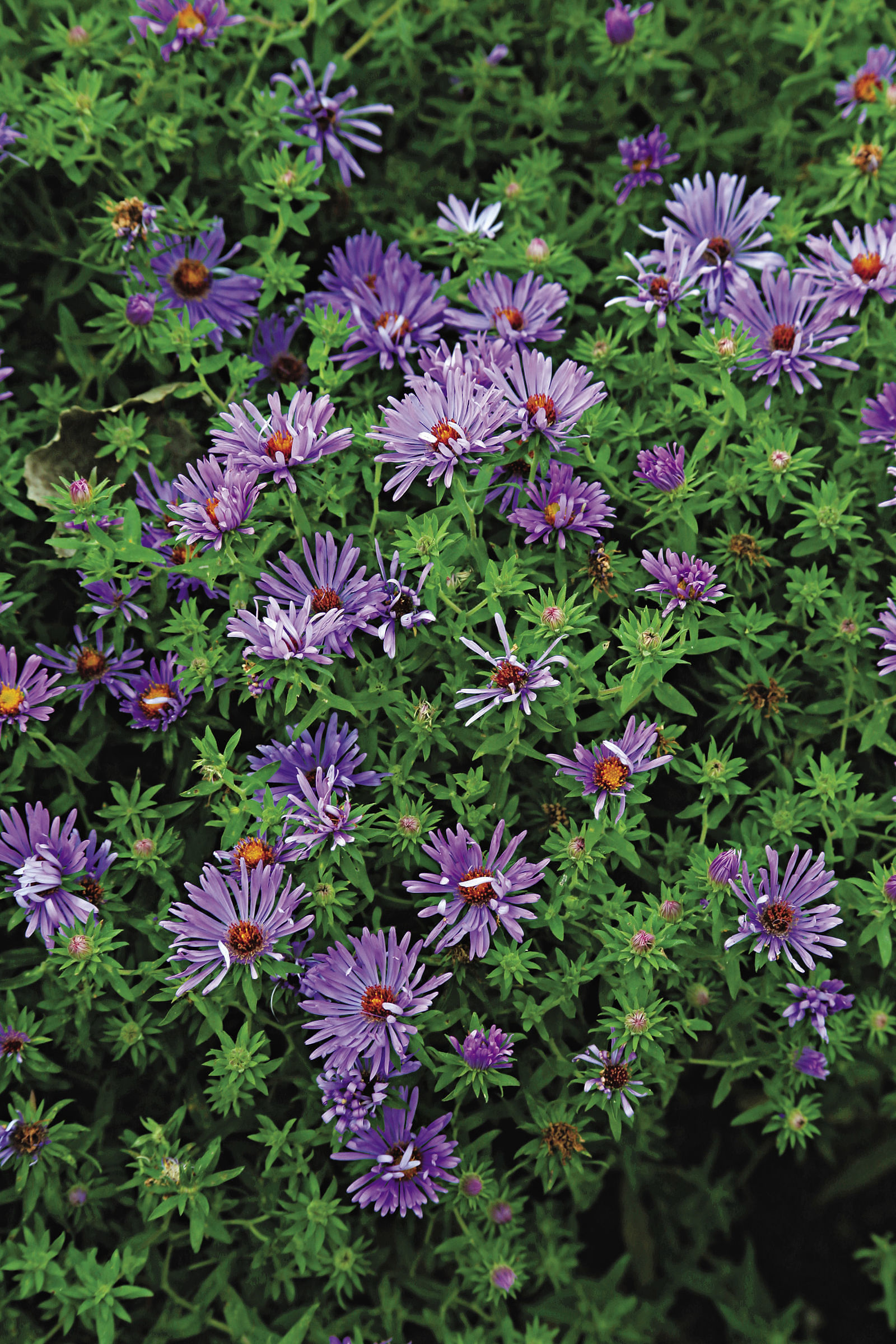
My first impression of ‘Doktor Otto Petschek’ Italian aster (Aster amellus ‘Doktor Otto Petschek’) as just another lavender-flowered aster was way off—as was the notion that it was named after a Bond villain. Flowers by the hundreds cloaked this compact clumper for weeks every fall, looking stunning and remaining healthy when many other asters were shabby or floppy. ‘Doktor Otto Petschek’ delivered year after year and is clearly a great disease-resistant alternative to New England and New York asters (Symphyotrichum novi-belgii). Italian asters, in general, like a lot of sun and need good drainage to stay healthy; cool nighttime temperatures are also preferred.

‘Lady in Black’ calico aster (Symphyotrichum lateriflorum ‘Lady in Black’) has a graceful profile with thin, wiry stems that arch out and over the large bushy plant. Sprays of white blossoms, just shy of half an inch across, cover the upper side of the horizontal branches in late summer. It’s hard not to get excited when the new leaves emerge bronze and then, amazingly, remain a strong purple all summer (full sun is essential to get the best color). Calico aster gets its name because the yellow disks at the center of the flowers change to purplish pink as they age—a pleasing color echo with the purple leaves of ‘Lady in Black’. While calico asters were untroubled by mildew, rabbits were harder to keep at bay.
Basics
Asters, in a nutshell
There are roughly 250 species of asters that are native to North America, Europe, and Asia. Although fairly ubiquitous, they are not without their challenges.
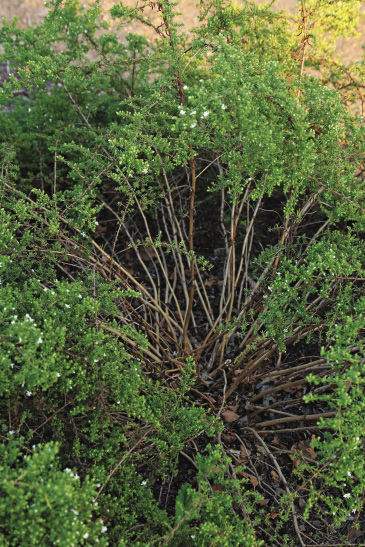
Division keeps plants healthy
Fast growers, such as New England aster, New York aster, calico aster, and flat-topped aster (Doellingeria umbellata), benefit from crown division every few years in early spring or autumn to reinvigorate the plants and keep them shapely. If left alone, the plants will die out in the centers.
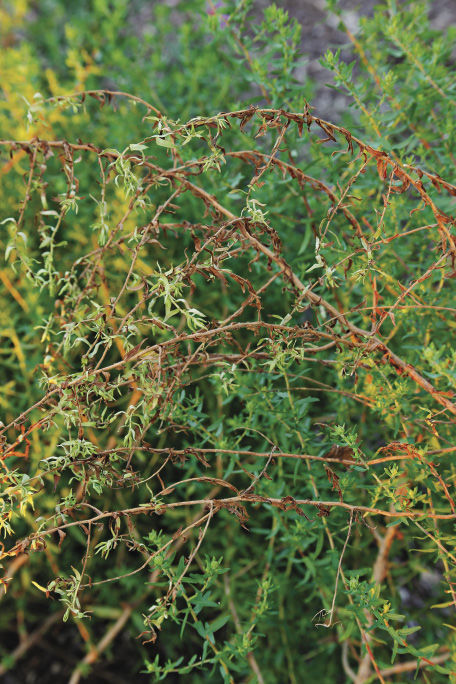
A new enemy is on the loose
Chrysanthemum lace bug (Corythucha marmorata), which became a problem in our trial in just the past few years, sucks nutrients from aster leaves, turning them sickly and off-colored. Severely infested plants drop most of their leaves and sometimes don’t recover. Only chemical controls, unfortunately, seem to be effective in combatting these pests.
Shade isn’t necessarily an issue
Asters generally grow best in moist, well-drained soils with plenty of sunlight. Woodland asters, such as blue wood aster (Symphyotrichum cordifolium), Drummond’s aster (S. drummondii), white wood aster (Eurybia divaricata), and bigleaf aster (E. macrophylla), tolerate deep shade but will produce the best flower displays with some morning sun.
Stake ’em or shear ’em
Tall asters might need staking, especially in shady or windy sites, but can be sheared to half their height in early to late spring to keep them shorter. Deadheading, while not required, will reduce unwanted seedlings.
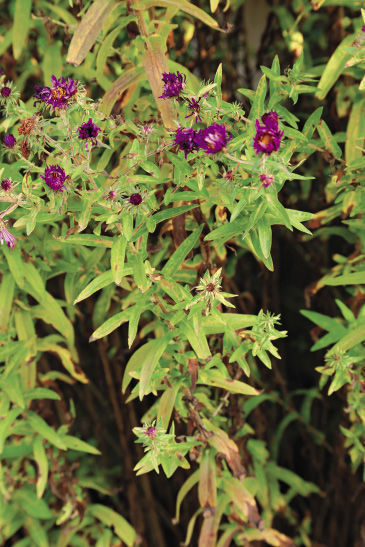
Want disease-free plants? Stay away from New England and New York
Powdery mildew and rust are potentially devastating diseases on some asters—marring leaves and sapping plant energy. Affected plants might drop their leaves, have reduced flower production, and just look shabby. Cultivars of New England aster were more troubled by powdery mildew in our trial, whereas cultivars and hybrids of New York aster were rarely rust-free.
Up-and-Comers to Check Out
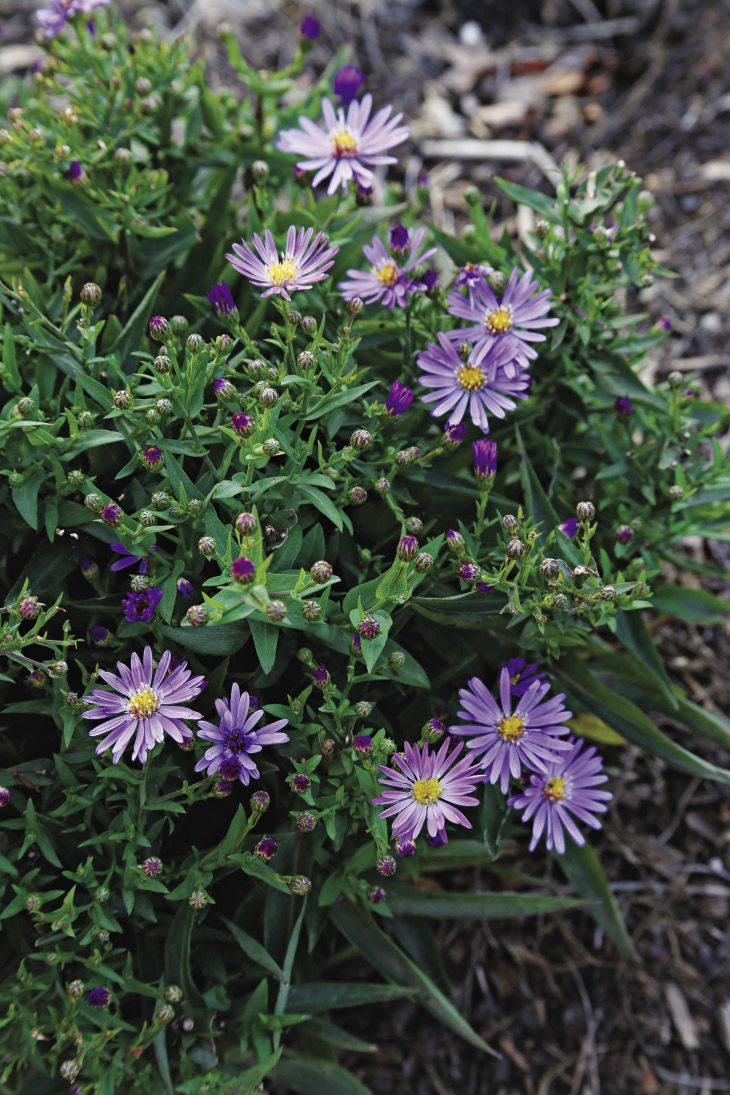
‘Arrested Development’ aster (Aster ‘Arrested Development’) is a new introduction noted for its short size. I’ve enjoyed its deep lavender-blue flowers whenever I can catch it in bloom—I have to be one step ahead of the rabbits, though. It touts an early-fall bloom date, a fact that we observed for the past two years, when as if on cue, the flowers opened on September 18. It is ironic that rabbits kept nibbling at the tips, thus arresting its development even further. Our plants topped out at 9 inches tall and 15 inches wide due to repeated browsing, but ‘Arrested Development’ should reach a bushy 12 to 15 inches tall and wide—without competition, of course.
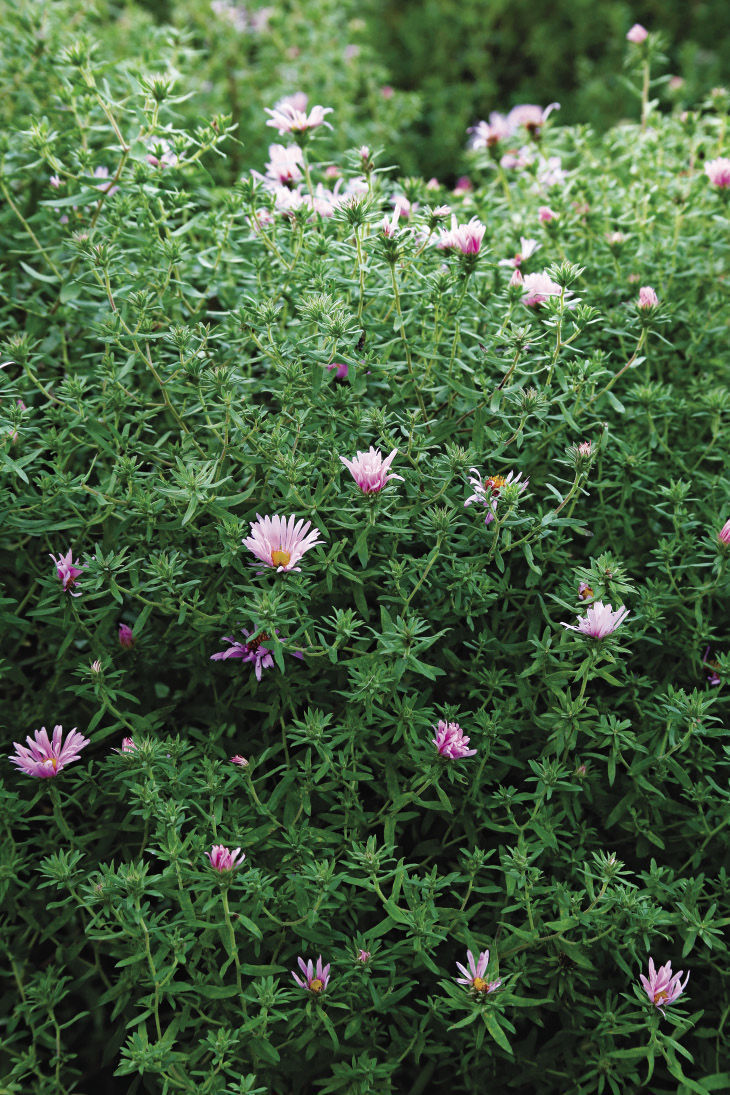
Given our affinity for ‘Raydon’s Favorite’, we naturally had high expectations for ‘Raydon’s Birthday Pink’ aromatic aster (Symphyotrichum oblongifolium ‘Raydon’s Birthday Pink’), and it did not disappoint. The first precocious flowers showed up in late summer, as if they just couldn’t wait for the party to begin. An exceptional display of light pink flowers, 1½ inches across, could be counted on from early to midfall. ‘Raydon’s Birthday Pink’ formed robust bushy mounds up to 32 inches tall and a whopping 84 inches wide, outpacing ‘Raydon’s Favorite’ by 30 inches. Mildew was no issue, but plants were minimally infested with lace bugs.

‘Bridal Veil’ aster (Symphyotrichum ‘Bridal Veil’) has its origin at the Chicago Botanic Garden; it was selected from a cross between ‘Snow Flurry’ and an unknown aster. ‘Bridal Veil’ has upward-arching stems that ultimately turn pendulous, developing a graceful weeping habit as the season progresses. Living up to its name, the fine-textured, cascading stems are thick with ½-inch-diameter white flowers from early fall on. At 40 inches tall and 68 inches wide, ‘Bridal Veil’ takes up some space, but its organic habit is worth it. Add mildew resistance as well as drought and salt tolerance to the mix and ‘Bridal Veil’ is perfect for both urban and naturalistic gardens.

We all know that fall is the time of asters, but ‘Napsbury’ East Indies aster (Aster tongolensis ‘Napsbury’) didn’t get the memo. Pretty lavender-and-orange flowers, 2½ inches across, rise above rosettes of dark green leaves for a month, starting in early summer. East Indies asters like relatively fertile, moist soils with good drainage, and will soak up all the sun you give them but won’t mind a bit of shade, too. At 14 inches tall and 20 inches wide, place ‘Napsbury’ right at the front of the border to enjoy its fleeting summer show to the fullest.
Aster Trial Results
Trial Parameters
How many: Since 2003, the Chicago Botanic Garden has evaluated 145 different asters in our comparative trials.
How long: A minimum of six years
Zone: 5b
Conditions: Full sun to full shade; alkaline, clay-loam, well-drained soil
Care: Minimal, allowing plants to thrive or fail under natural conditions
Observations: Ornamental traits; growth and adaptation to environmental and soil conditions; disease or pest problems; plant injury or winter losses
| Rating | Name | Height | Width | Flower color | Flower size (dia.) | Flower production | Mildew resistance | Rust resistance |
| ★ ★ ★ | Aster amellus ‘Doktor Otto Petschek’ | 20 in. | 36 in. | Lavender | 1¼ in. | Heavy | Excellent | Excellent |
| ★ | Aster frikartii ‘Mönch’ | 22 in. | 32 in. | Lavender-blue | 2 in. | Moderate | Excellent | Poor |
| ★ | Aster frikartii ‘Wunder von Stäfa’ | 23 in. | 32 in. | Lavender-blue | 2 in. | Low | Excellent | Fair |
| ★ ★ ★ ★ | Aster tataricus ‘Jindai’ | 40 in. | 32 in. | Violet-blue | 1 in. | Heavy | Excellent | Excellent |
| ★ ★ ★ | Aster tongolensis ‘Wartburgstern’ | 20 in. | 24 in. | Violet-blue | 2 in. | Moderate | Excellent | Good |
| ★ ★ ★ | Doellingeria umbellata | 60 in. | 55 in. | White | ½ in. | Heavy | Excellent | Excellent |
| ★ ★ ★ ★ | Eurybia divaricata | 24 in. | 46 in. | White | ¾ in. | Heavy | Excellent | Excellent |
| ★ ★ ★ ★ | Eurybia divaricata ‘Eastern Star’ | 21 in. | 36 in. | White | 1¼ in. | Heavy | Excellent | Excellent |
| ★ ★ | Eurybia macrophylla | 49 in. | 36 in. | Light purple | 1½ in. | Heavy | Excellent | Very poor |
| ★ ★ | Symphyotrichum ‘Bill’s Big Blue’ | 58 in. | 52 in. | Lavender-blue | 1 in. | Low | Good | Excellent |
| ★ ★ ★ | Symphyotrichum ‘Cape Cod’ | 49 in. | 62 in. | White | 5⁄8 in. | Heavy | Excellent | Excellent |
| ★ ★ | Symphyotrichum ‘Cassie’ | 36 in. | 30 in. | Light purple | 1¼ in. | Moderate | Fair | Excellent |
| ★ | Symphyotrichum ‘Celeste’ | 35 in. | 28 in. | Violet | 1 in. | Low | Excellent | Very poor |
| ★ | Symphyotrichum ‘Coombe Fishacre’ | 34 in. | 34 in. | Pink | ¾ in. | Low | Very poor | Excellent |
| ★ ★ ★ | Symphyotrichum ‘Kylie’ | 46 in. | 40 in. | Pale pink | ¾ in. | Heavy | Excellent | Excellent |
| ★ | Symphyotrichum ‘Lilac Blue Admiral’ | 39 in. | 34 in. | Lavender | ¾ in. | Low | Good | Very poor |
| ★ | Symphyotrichum ‘Melody’ | 27 in. | 24 in. | Lavender | 1½ in. | Moderate | Very poor | Very poor |
| ★ ★ | Symphyotrichum ‘Milka’ | 36 in. | 28 in. | Light violet | 1 in. | Moderate | Good | Fair |
| ★ ★ | Symphyotrichum ‘Miss Bessie’ | 59 in. | 40 in. | Lavender | 1 in. | N/A | Good | Good |
| ★ ★ | Symphyotrichum ‘Ochtendgloren’ | 40 in. | 40 in. | Purple-pink | ¾ in. | Moderate | Excellent | Very poor |
| ★ | Symphyotrichum ‘Red Star’ | 15 in. | 21 in. | Magenta | 1½ in. | Low | Very poor | Poor |
| ★ ★ | Symphyotrichum ‘White Climax’ | 50 in. | 36 in. | White | 1¼ in. | Moderate | Poor | Excellent |
| ★ ★ | Symphyotrichum cordifolium ‘Ideal’ | 60 in. | 35 in. | Lavender | ¾ in. | Heavy | Excellent | Poor |
| ★ ★ ★ | Symphyotrichum drummondii var. drummondii | 49 in. | 45 in. | Lavender-blue | ¾ in. | Moderate | Good | Excellent |
| ★ | Symphyotrichum ericoides ‘Blue Star’ | 33 in. | 50 in. | Pale blue | ½ in. | Heavy | Excellent | Very poor |
| ★ ★ ★ | Symphyotrichum ericoides ‘Erlkönig’ | 42 in. | 56 in. | Pale lavender-blue | ½ in. | Heavy | Good | Good |
| ★ ★ ★ | Symphyotrichum ericoides ‘First Snow’ | 19 in. | 40 in. | White | ½ in. | Heavy | Excellent | Fair |
| ★ ★ ★ ★ | Symphyotrichum ericoides ‘Snow Flurry’ | 8 in. | 48 in. | White | 3⁄8 in. | Heavy | Excellent | Excellent |
| ★ | Symphyotrichum laeve ‘Bluebird’ | 49 in. | 36 in. | Violet-blue | 1 in. | Low | Excellent | Good |
| ★ | Symphyotrichum laeve ‘Calliope’ | 57 in. | 60 in. | Lilac-purple | 13⁄8 in. | Moderate | Excellent | Very poor |
| ★ ★ ★ ★ | Symphyotrichum lateriflorum | 39 in. | 60 in. | White | 3⁄8 in. | Heavy | Excellent | Excellent |
| ★ ★ ★ ★ | Symphyotrichum lateriflorum ‘Lady in Black’ | 34 in. | 50 in. | White | ½ in. | Heavy | Excellent | Excellent |
| ★ ★ ★ | Symphyotrichum lateriflorum ‘Lovely’ | 25 in. | 26 in. | Pale purple | 3⁄8 in. | Moderate | Excellent | Excellent |
| ★ ★ | Symphyotrichum novae-angliae ‘Andenken an Alma Pötschke’ | 38 in. | 60 in. | Cerise-pink | 1½ in. | Heavy | Fair | Excellent |
| ★ ★ | Symphyotrichum novae-angliae ‘Andenken an Paul Gerbe’ | 52 in. | 49 in. | Purple-pink | 1½ in. | Moderate | Fair | Excellent |
| ★ ★ | Symphyotrichum novae-angliae ‘Barr’s Blue’ | 55 in. | 68 in. | Purple-blue | 1½ in. | Heavy | Poor | Excellent |
| ★ ★ ★ | Symphyotrichum novae-angliae ‘Harrington’s Pink’ | 60 in. | 50 in. | Rosy pink | 1¼ in. | Heavy | Fair | Excellent |
| ★ | Symphyotrichum novae-angliae ‘Hella Lacy’ | 34 in. | 48 in. | Light violet-blue | 1 in. | Low | Very poor | Excellent |
| ★ ★ ★ | Symphyotrichum novae-angliae ‘Honeysong Pink’ | 59 in. | 40 in. | Deep pink | 1½ in. | Heavy | Fair | Excellent |
| ★ ★ | Symphyotrichum novae-angliae ‘Mrs. S. T. Wright’ | 49 in. | 53 in. | Purple | 2¼ in. | Moderate | Poor | Excellent |
| ★ ★ | Symphyotrichum novae-angliae ‘Purple Dome’ | 16 in. | 24 in. | Violet-purple | 1½ in. | Heavy | Fair | Excellent |
| ★ ★ | Symphyotrichum novae-angliae ‘Treasure’ | 64 in. | 38 in. | Purple | 2 in. | Heavy | Poor | Excellent |
| ★ ★ | Symphyotrichum novae-angliae ‘Wedding Lace’ | 64 in. | 54 in. | White | 1¾ in. | Heavy | Poor | Excellent |
| ★ | Symphyotrichum novi-belgii ‘Alice Haslem’ | 12 in. | 20 in. | Light red | 1½ in. | Heavy | Very poor | Excellent |
| ★ ★ | Symphyotrichum novi-belgii ‘Blaubox’ | 28 in. | 32 in. | Light lavender | 1½ in. | Heavy | Very poor | Good |
| ★ | Symphyotrichum novi-belgii ‘Blue Lagoon’ | 19 in. | 28 in. | Violet-blue | 1 in. | Heavy | Excellent | Very poor |
| ★ ★ | Symphyotrichum novi-belgii ‘Blue Lake’ | 55 in. | 50 in. | Violet-blue | 1 in. | Low | Excellent | Very poor |
| ★ | Symphyotrichum novi-belgii ‘Boningale White’ | 21 in. | 21 in. | White | 2 in. | Low | Very poor | Excellent |
| ★ | Symphyotrichum novi-belgii ‘Butterfly Blue’ | 32 in. | 22 in. | Lavender | ¾ in. | Low | Very poor | Good |
| ★ ★ | Symphyotrichum novi-belgii ‘Choristers’ | 64 in. | 75 in. | White | ½ in. | Heavy | Excellent | Poor |
| ★ ★ ★ | Symphyotrichum novi-belgii ‘Climax’ | 46 in. | 40 in. | Lavender-blue | 1¼ in. | Heavy | Excellent | Excellent |
| ★ | Symphyotrichum novi-belgii ‘Daniela’ | 12 in. | 24 in. | Purple | 1¼ in. | Low | Excellent | Very poor |
| ★ | Symphyotrichum novi-belgii ‘Freda Ballard’ | 20 in. | 18 in. | Purple-red | 1¼ in. | Low | Poor | Excellent |
| ★ | Symphyotrichum novi-belgii ‘Harrison’s Blue’ | 36 in. | 38 in. | Violet-blue | 1½ in. | Heavy | Poor | Very poor |
| ★ | Symphyotrichum novi-belgii ‘Jenny’ | 14 in. | 17 in. | Purple-red | 1½ in. | Low | Excellent | Very poor |
| ★ | Symphyotrichum novi-belgii ‘Kiesapphire Sapphire’ | 24 in. | 22 in. | Vivid violet | 1½ in. | Low | Excellent | Very poor |
| ★ ★ | Symphyotrichum novi-belgii ‘Lady in Blue’ | 14 in. | 30 in. | Lavender-blue | 1¼ in. | Low | Excellent | Very poor |
| ★ | Symphyotrichum novi-belgii ‘Marie Ballard’ | 32 in. | 20 in. | Lavender-blue | 1¾ in. | Low | Poor | Fair |
| ★ ★ | Symphyotrichum novi-belgii ‘Mariore’ | 18 in. | 30 in. | Pink | 1¼ in. | Heavy | Very poor | Very poor |
| ★ ★ | Symphyotrichum novi-belgii ‘Porzellan’ | 62 in. | 60 in. | Light purple | 1½ in. | Heavy | Good | Very poor |
| ★ | Symphyotrichum novi-belgii ‘Professor Anton Kippenberg’ | 11 in. | 26 in. | Lavender-blue | 1 in. | Low | Excellent | Very poor |
| ★ ★ ★ | Symphyotrichum novi-belgii ‘Rosenwichtel’ | 12 in. | 30 in. | Purple-pink | 1¼ in. | Heavy | Excellent | Excellent |
| ★ ★ | Symphyotrichum novi-belgii ‘Schneekissen’ (‘Snow Cushion’) | 10 in. | 16 in. | White | 1 in. | Moderate | Excellent | Good |
| ★ ★ | Symphyotrichum novi-belgii ‘Violet Carpet’ | 9 in. | 36 in. | Violet-blue | 1 in. | Low | Excellent | Good |
| ★ | Symphyotrichum novi-belgii ‘White Swan’ | 36 in. | 28 in. | White | 1½ in. | Moderate | Very poor | Excellent |
| ★ ★ | Symphyotrichum novi-belgii ‘Wood’s Blue’ | 11 in. | 30 in. | Lavender-blue | 1½ in. | Low | Good | Excellent |
| ★ ★ | Symphyotrichum novi-belgii ‘Wood’s Light Blue’ | 8 in. | 24 in. | Light blue | 1 in. | Heavy | Excellent | Excellent |
| ★ ★ | Symphyotrichum novi-belgii ‘Wood’s Purple’ | 9 in. | 18 in. | Purple | 1¼ in. | Moderate | Excellent | Excellent |
| ★ ★ ★ | Symphyotrichum oblongifolium | 36 in. | 40 in. | Lavender-blue | 1½ in. | Moderate | Excellent | Excellent |
| ★ ★ ★ | Symphyotrichum oblongifolium ‘Fanny’s Aster’ | 47 in. | 40 in. | Light purple | 1¼ in. | Moderate | Good | Excellent |
| ★ ★ ★ | Symphyotrichum oblongifolium ‘October Skies’ | 35 in. | 50 in. | Lavender-blue | 1¼ in. | Moderate | Fair | Excellent |
| ★ ★ ★ ★ | Symphyotrichum oblongifolium ‘Raydon’s Favorite’ | 38 in. | 53 in. | Blue-purple | 1¼ in. | Heavy | Excellent | Excellent |
| ★ ★ ★ | Symphyotrichum oblongifolium var. angustatus | 35 in. | 65 in. | Lavender-blue | 1¼ in. | Moderate | Excellent | Excellent |
| ★ ★ | Symphyotrichum oolentangiense | 45 in. | 28 in. | Lavender | 1 in. | Low | Fair | Excellent |
| ★ ★ | Symphyotrichum sericeum | 22 in. | 32 in. | Purple-blue | 1½ in. | Low | Excellent | Excellent |
| ★ ★ ★ | Symphyotrichum turbinellum | 58 in. | 56 in. | Violet-blue | 1¼ in. | Heavy | Good | Excellent |
Rating key
★★★★ Excellent
★★★ Good
★★ Fair
★ Poor
Richard Hawke is the plant-evaluation manager at the Chicago Botanic Garden in Glencoe, Illinois.
SOURCES
The following mail-order plant sellers offer many of the asters featured:
• Far Reaches Farm, Port Townsend, Wash.; 360-385-5114; farreachesfarm.com
• Joy Creek Nursery, Scappoose, Ore.; 503-543-7474; joycreek.com
• Lazy S’S Farm Nursery, 2360 Spotswood Trail, Barboursville, VA 22923; lazyssfarm.com
• Stokes Seeds, Buffalo, N.Y.; 800-396-9238; stokeseeds.com
For the complete chart of results from the aster trial, go to FineGardening.com/extras.
Photos, except where noted: Danielle Sherry. Other photos: Nancy J. Ondra; courtesy of Forestfarm; Jennifer Benner.
Fine Gardening Recommended Products

A.M. Leonard Deluxe Soil Knife & Leather Sheath Combo
Fine Gardening receives a commission for items purchased through links on this site, including Amazon Associates and other affiliate advertising programs.




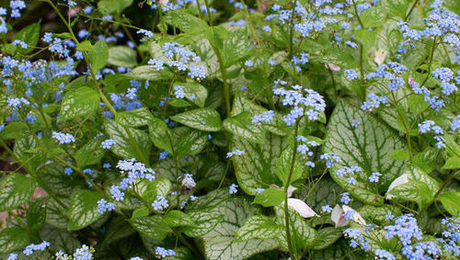













Comments
Log in or create an account to post a comment.
Sign up Log in